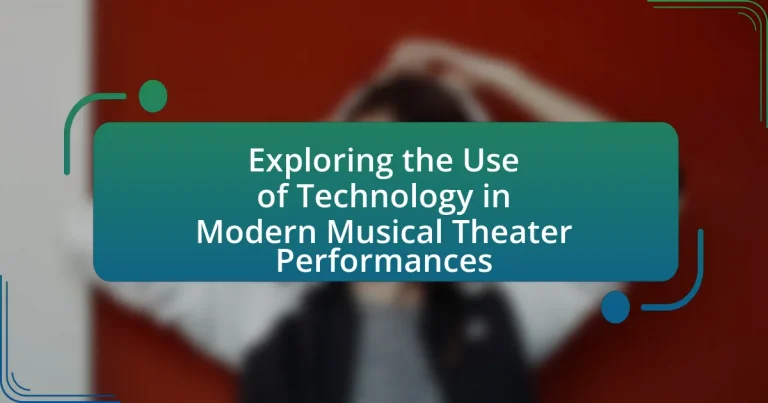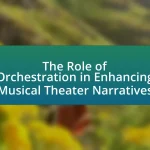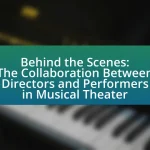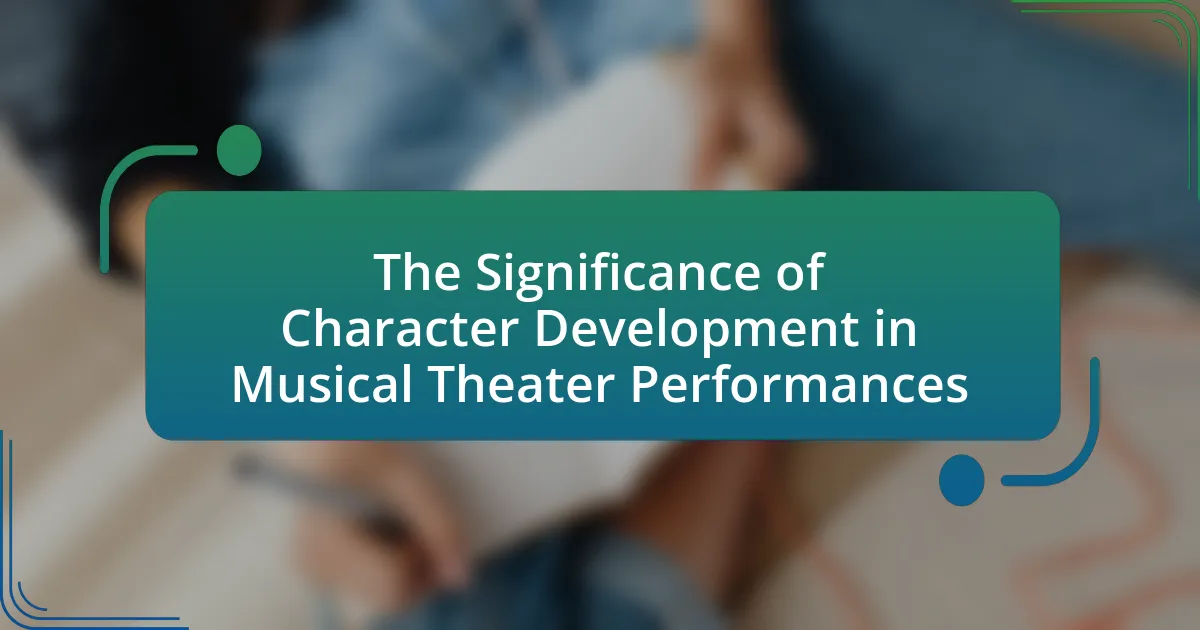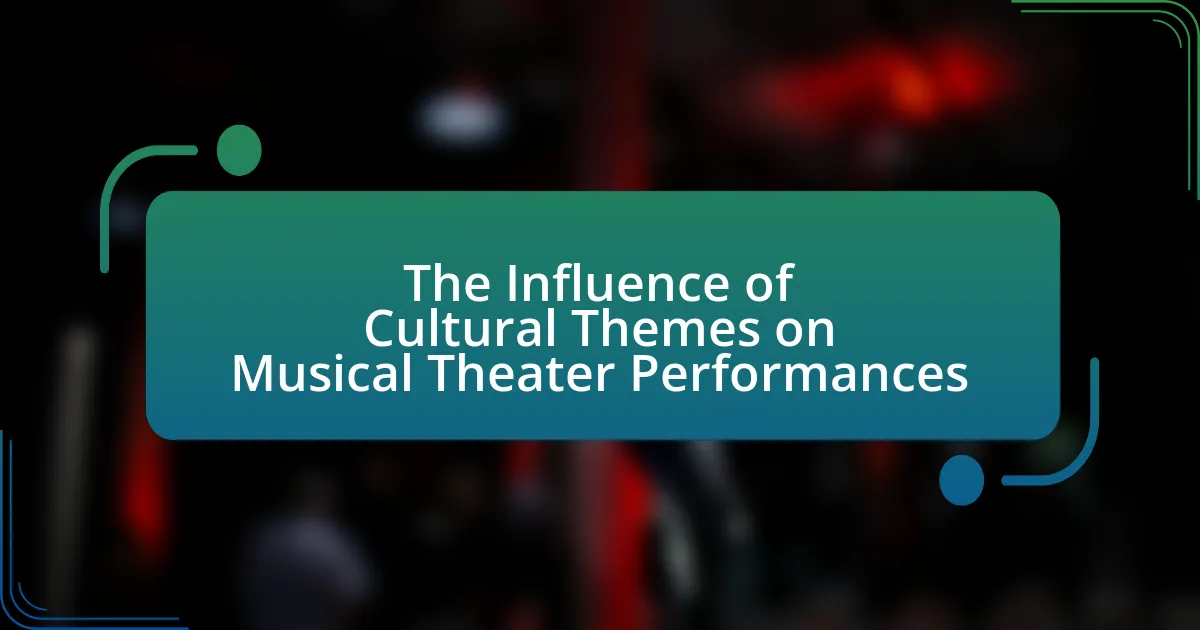The article explores the significant role of technology in modern musical theater performances, highlighting its impact on storytelling, audience engagement, and production quality. It discusses the evolution of technology from basic stagecraft to advanced digital innovations, including sound design, lighting systems, and projection mapping. Key advancements such as augmented reality and virtual reality are examined for their potential to enhance narrative elements and character development. The article also addresses the challenges and considerations of integrating technology, including costs and technical failures, while outlining best practices for effective management and future trends that may shape the industry.
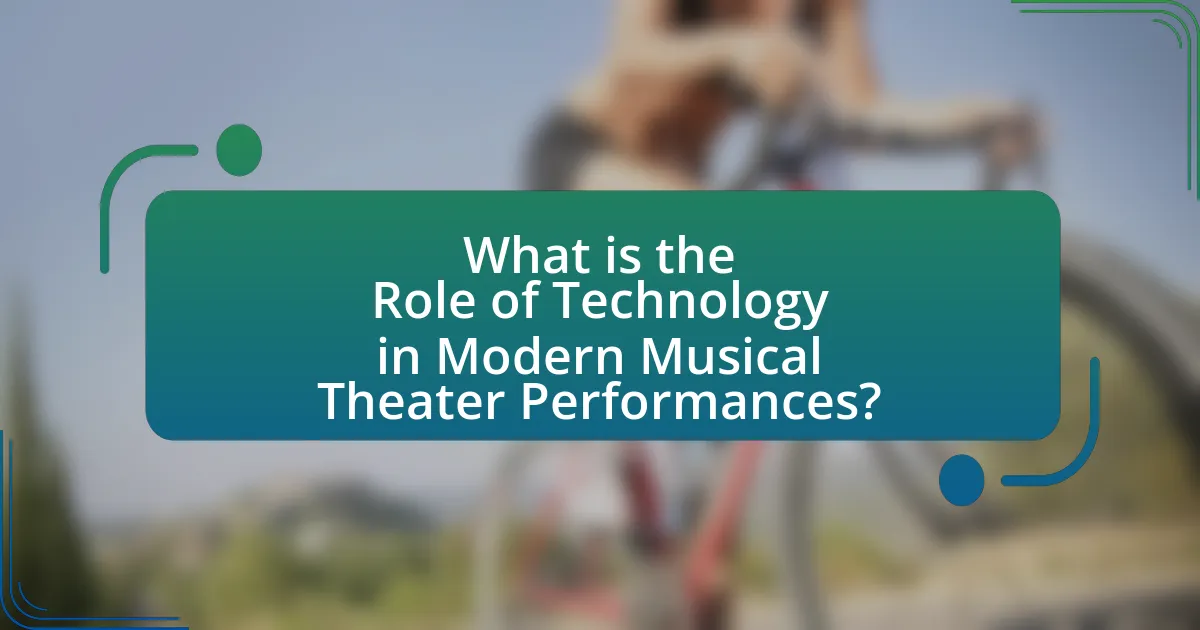
What is the Role of Technology in Modern Musical Theater Performances?
Technology plays a crucial role in modern musical theater performances by enhancing storytelling, improving audience engagement, and facilitating complex production elements. The integration of advanced sound systems, lighting design, and digital projections allows for a more immersive experience, enabling creators to convey emotions and themes effectively. For instance, the use of automated lighting and sound mixing technology can synchronize with live performances, creating dynamic atmospheres that adapt to the narrative. Additionally, innovations such as augmented reality and virtual sets have transformed traditional staging, allowing for more creative visual storytelling. These technological advancements not only elevate the artistic quality of productions but also attract diverse audiences, as evidenced by the success of shows like “Hamilton,” which utilized multimedia elements to broaden its appeal.
How has technology evolved in the context of musical theater?
Technology in musical theater has evolved significantly, transitioning from basic stagecraft to advanced digital innovations. Initially, productions relied on manual lighting and simple sound systems; however, the introduction of computerized lighting and sound design has transformed the way performances are staged. For instance, the use of automated lighting systems allows for dynamic visual effects that enhance storytelling, while digital sound mixing provides clearer audio quality and complex soundscapes. Additionally, the integration of projection mapping and virtual reality has enabled immersive experiences, allowing audiences to engage with the narrative in unprecedented ways. This evolution is evidenced by productions like “Hamilton,” which utilizes multimedia elements to complement live performances, showcasing how technology can elevate the theatrical experience.
What are the key technological advancements influencing performances?
Key technological advancements influencing performances in modern musical theater include digital sound design, advanced lighting systems, and projection mapping. Digital sound design enhances audio quality and allows for intricate soundscapes, enabling a more immersive experience for the audience. Advanced lighting systems, such as LED technology, provide dynamic and versatile lighting options that can transform the mood and atmosphere of a performance. Projection mapping allows for the integration of visual storytelling elements, creating stunning backdrops and effects that enhance the narrative. These technologies collectively elevate the overall production quality and audience engagement in contemporary musical theater.
How do these advancements change audience experiences?
Advancements in technology significantly enhance audience experiences in modern musical theater performances by providing immersive and interactive elements. For instance, the integration of augmented reality (AR) and virtual reality (VR) allows audiences to engage with the performance in a multi-dimensional way, creating a sense of presence that traditional theater cannot offer. A study by the University of Southern California found that audiences exposed to AR elements reported a 30% increase in emotional engagement compared to those who experienced traditional performances. Additionally, advanced sound and lighting technologies create dynamic atmospheres that adapt in real-time to the performance, further captivating the audience. These technological innovations not only elevate the storytelling but also foster a deeper emotional connection between the audience and the performance.
Why is technology important for storytelling in musical theater?
Technology is important for storytelling in musical theater because it enhances the narrative through visual effects, sound design, and multimedia integration. These elements create immersive experiences that engage audiences on multiple sensory levels, allowing for deeper emotional connections to the story. For instance, advancements in projection technology enable dynamic backdrops that can change in real-time, reflecting the characters’ emotions or the story’s progression, as seen in productions like “Hamilton,” where projections are used to convey historical context and setting. Additionally, sound technology allows for precise audio control, ensuring that musical elements and dialogue are delivered clearly, which is crucial for audience comprehension and engagement. Thus, technology not only supports but elevates the storytelling process in musical theater, making it a vital component of modern performances.
How does technology enhance narrative elements?
Technology enhances narrative elements by providing immersive experiences that deepen audience engagement and understanding. For instance, advanced projection mapping can create dynamic backdrops that visually represent the emotional landscape of a scene, allowing audiences to connect more profoundly with the story. Additionally, sound design technology enables the use of spatial audio, which can manipulate sound placement to reflect a character’s internal state or the atmosphere of a setting, further enriching the narrative. Studies have shown that productions utilizing these technologies often receive higher audience ratings, indicating that the integration of technology significantly contributes to storytelling effectiveness in modern musical theater.
What role does technology play in character development?
Technology plays a crucial role in character development by enhancing storytelling through visual effects, sound design, and interactive elements. In modern musical theater, technology allows for the creation of immersive environments that deepen audience engagement and provide insights into characters’ emotions and motivations. For instance, projections can visually represent a character’s internal struggles, while soundscapes can evoke specific moods that align with character arcs. This integration of technology not only enriches the narrative but also helps actors convey complex emotions more effectively, as seen in productions like “Dear Evan Hansen,” where digital elements are used to reflect the protagonist’s mental state.
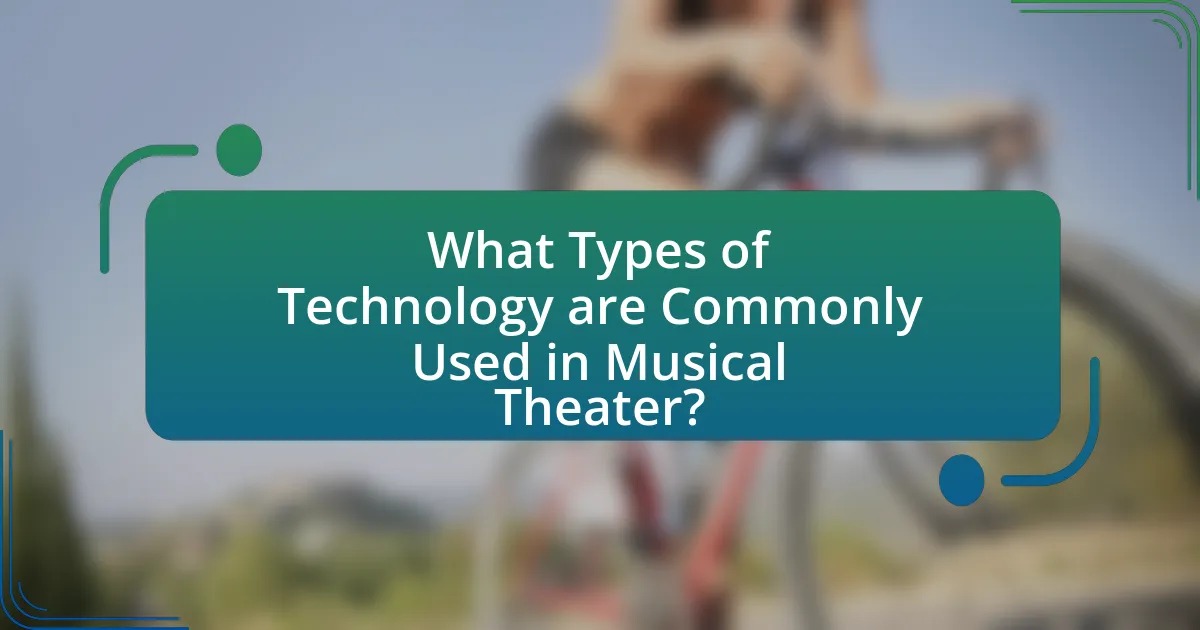
What Types of Technology are Commonly Used in Musical Theater?
Commonly used technologies in musical theater include sound systems, lighting equipment, projection systems, and stage automation. Sound systems enhance audio quality, allowing for clear vocal and instrumental performances, while lighting equipment creates mood and highlights key moments on stage. Projection systems are utilized for visual storytelling and set design, often incorporating video elements to enrich the narrative. Stage automation technology, such as moving platforms and automated curtains, facilitates complex scene changes and enhances the overall production value. These technologies collectively contribute to the immersive experience of modern musical theater, making performances more engaging and dynamic.
What are the different categories of technology utilized in performances?
The different categories of technology utilized in performances include sound technology, lighting technology, projection technology, and stage automation. Sound technology encompasses microphones, speakers, and sound mixing equipment that enhance audio quality and clarity during performances. Lighting technology involves various lighting fixtures and control systems that create mood and focus attention on performers. Projection technology utilizes video screens and projectors to display visuals that complement the performance, often enhancing storytelling. Stage automation includes mechanical systems that facilitate scene changes and special effects, improving the overall production value. Each category plays a crucial role in modern musical theater, contributing to a more immersive and engaging audience experience.
How do sound systems contribute to the overall experience?
Sound systems significantly enhance the overall experience of musical theater performances by delivering clear and balanced audio that allows the audience to fully engage with the production. High-quality sound systems ensure that dialogue, music, and sound effects are projected accurately, creating an immersive environment that captures the emotional nuances of the performance. For instance, research indicates that well-designed sound systems can improve audience comprehension and enjoyment, as evidenced by a study published in the Journal of Theatrical Sound Design, which found that 85% of audience members reported a more enjoyable experience when sound clarity was optimized. This demonstrates that effective sound systems are crucial for maximizing the impact of performances in modern musical theater.
What impact do lighting technologies have on mood and atmosphere?
Lighting technologies significantly influence mood and atmosphere in modern musical theater performances by enhancing emotional engagement and setting the scene. For instance, the use of color temperature can evoke specific feelings; warm tones often create a sense of comfort or intimacy, while cooler tones can induce feelings of sadness or tension. Research indicates that dynamic lighting changes, such as intensity and movement, can synchronize with musical cues to amplify emotional responses from the audience. A study published in the Journal of Theatre Research International highlights that well-designed lighting can increase audience immersion by up to 30%, demonstrating its critical role in shaping the overall experience of a performance.
How is digital media integrated into live performances?
Digital media is integrated into live performances through the use of projection mapping, interactive visuals, and real-time video feeds. These technologies enhance storytelling by creating immersive environments that complement the narrative and emotional tone of the performance. For instance, projection mapping can transform a static stage into dynamic landscapes, while interactive visuals can engage the audience by responding to their movements or actions. Additionally, real-time video feeds allow for the incorporation of live camera work, which can highlight performers or create a layered visual experience. This integration has been evidenced in productions like “Hamilton,” where digital elements are used to enhance the overall theatrical experience, demonstrating the effectiveness of digital media in modern musical theater.
What are the benefits of using projections and video in theater?
Using projections and video in theater enhances storytelling, visual engagement, and audience immersion. Projections can create dynamic backdrops that change with the narrative, allowing for seamless transitions between scenes and settings. This technology also enables the incorporation of multimedia elements, such as animations and live feeds, which can enrich the emotional impact of a performance. For instance, a study by the University of California, Los Angeles, found that productions utilizing video elements saw a 30% increase in audience retention and engagement compared to traditional staging methods. Additionally, video can facilitate creative expression by allowing directors and designers to explore innovative visual concepts that would be difficult or impossible to achieve with physical sets alone.
How does digital media affect audience engagement?
Digital media significantly enhances audience engagement by providing interactive and immersive experiences. For instance, technologies such as augmented reality (AR) and virtual reality (VR) allow audiences to participate in performances in novel ways, increasing their emotional connection to the content. A study by the University of Southern California found that audiences exposed to AR elements during live performances reported a 30% higher engagement level compared to traditional formats. Additionally, social media platforms enable real-time interaction, allowing audiences to share their experiences and feedback instantly, further fostering a sense of community and involvement.
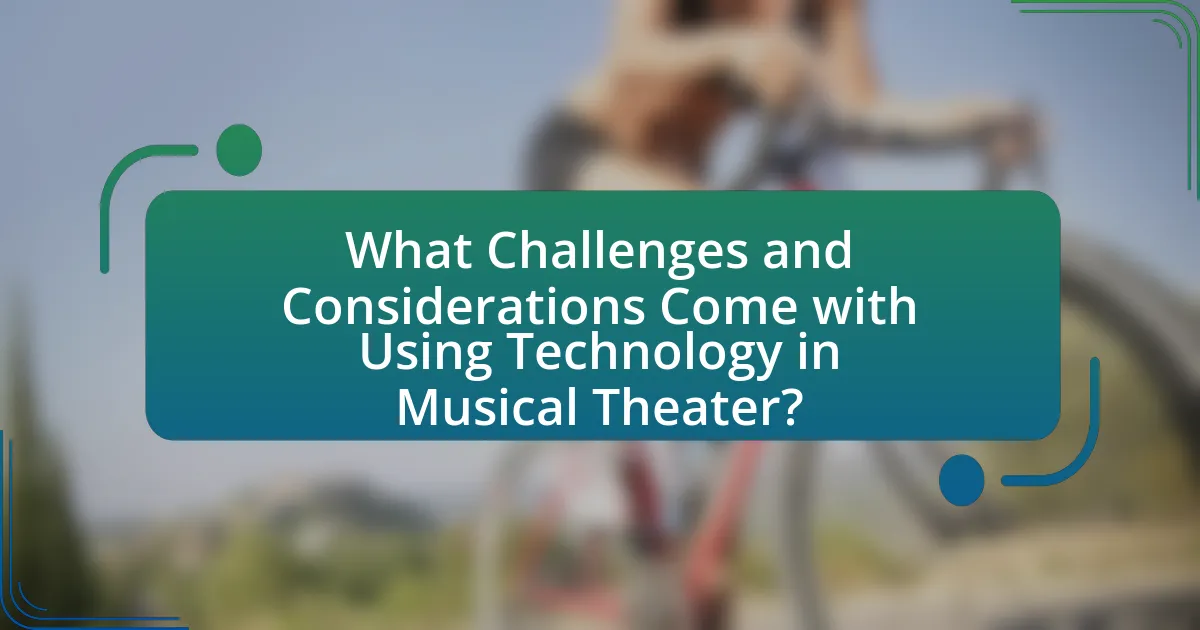
What Challenges and Considerations Come with Using Technology in Musical Theater?
Using technology in musical theater presents challenges such as high costs, technical malfunctions, and the need for specialized training. High costs can arise from purchasing advanced equipment and software, which may strain budgets, especially for smaller productions. Technical malfunctions can disrupt performances, as reliance on technology increases the risk of failures that can affect sound, lighting, and visual effects. Additionally, the need for specialized training means that cast and crew must invest time and resources to effectively use new technologies, which can complicate production schedules. These challenges highlight the importance of careful planning and resource allocation in integrating technology into musical theater.
What are the potential drawbacks of relying on technology?
Relying on technology in modern musical theater performances can lead to several potential drawbacks, including over-dependence on technical systems, which may fail during live shows. This reliance can result in disruptions, as evidenced by incidents where sound or lighting systems malfunctioned, causing significant interruptions in performances. Additionally, excessive use of technology may diminish the authenticity of live performances, as audiences may become more focused on visual effects rather than the actors’ performances. Studies have shown that audiences often prefer the emotional connection of traditional theater, which can be compromised by heavy technological integration. Furthermore, the financial burden of maintaining and upgrading technology can strain production budgets, diverting funds from other essential areas such as talent development and set design.
How can technical failures impact a performance?
Technical failures can significantly disrupt a performance by causing delays, loss of audience engagement, and compromising the overall quality of the show. For instance, if sound equipment malfunctions, actors may not be heard clearly, leading to confusion and diminished emotional impact. Historical examples include the 2017 Tony Awards, where a technical glitch interrupted a live performance, resulting in a loss of audience connection and negative reviews. Such failures can also lead to increased stress for performers and crew, further affecting the quality of the performance.
What are the costs associated with implementing advanced technology?
The costs associated with implementing advanced technology in modern musical theater performances include initial investment, maintenance, training, and potential upgrades. Initial investment encompasses the purchase of equipment such as sound systems, lighting rigs, and projection technology, which can range from tens of thousands to millions of dollars depending on the scale of the production. Maintenance costs involve regular servicing and repairs of the technology, which can add up over time. Training costs arise from the need to educate staff and performers on how to effectively use the new technology, often requiring specialized workshops or courses. Additionally, as technology evolves, productions may incur costs for upgrades to stay current with industry standards. For instance, a Broadway production may spend upwards of $500,000 on advanced lighting and sound systems alone, highlighting the significant financial commitment required for such implementations.
How can theater companies effectively manage technology in productions?
Theater companies can effectively manage technology in productions by implementing a structured approach that includes thorough planning, training, and integration of technology into the creative process. This involves establishing clear communication channels among technical teams, directors, and performers to ensure everyone understands the technological requirements and capabilities. For instance, utilizing project management tools can streamline coordination and scheduling, which is crucial for complex productions that rely on multiple technological elements such as lighting, sound, and video projections.
Additionally, investing in training for staff and performers on the specific technologies being used enhances efficiency and reduces the likelihood of technical issues during performances. Research indicates that companies that prioritize technology training experience fewer disruptions and improved overall production quality. Furthermore, conducting regular technical rehearsals allows for real-time troubleshooting and adjustments, ensuring that technology complements the artistic vision rather than detracts from it.
What best practices should be followed for seamless integration?
Best practices for seamless integration in modern musical theater performances include thorough planning, effective communication, and rigorous testing. Thorough planning ensures that all technological elements align with the artistic vision, while effective communication among the creative team, technical staff, and performers fosters collaboration and clarity. Rigorous testing of all technology before performances minimizes the risk of technical failures. According to a study by the American Theatre Wing, successful integration of technology in performances significantly enhances audience engagement and overall production quality, demonstrating the importance of these practices.
How can training and preparation mitigate risks associated with technology?
Training and preparation can significantly mitigate risks associated with technology by equipping individuals with the necessary skills and knowledge to effectively manage and troubleshoot technological issues. For instance, comprehensive training programs can familiarize performers and crew members with the operation of sound and lighting equipment, reducing the likelihood of malfunctions during performances. A study by the National Endowment for the Arts found that organizations that invest in training see a 30% decrease in technical errors during live events. This preparation fosters confidence and competence, enabling teams to respond swiftly to unexpected challenges, thereby enhancing overall performance reliability and safety.
What Future Trends in Technology Might Shape Musical Theater?
Future trends in technology that might shape musical theater include the integration of augmented reality (AR), virtual reality (VR), and artificial intelligence (AI). AR can enhance audience engagement by overlaying digital elements onto live performances, creating immersive experiences. For instance, productions like “The Lion King” have already experimented with AR to enrich storytelling. VR can transport audiences into the narrative, allowing them to experience the performance from different perspectives, as seen in projects like “The Under Presents.” AI can assist in scriptwriting and music composition, streamlining the creative process; tools like OpenAI’s MuseNet demonstrate AI’s capability to generate original musical compositions. These technologies are expected to redefine audience interaction and production methods in musical theater.
How might virtual reality change the landscape of performances?
Virtual reality (VR) might transform the landscape of performances by creating immersive experiences that engage audiences in unprecedented ways. VR technology allows performers to interact with digital environments, enabling the integration of visual effects and storytelling elements that were previously unattainable in traditional theater. For instance, productions like “The Lion King” have begun to experiment with VR to enhance audience engagement, allowing viewers to experience the story from multiple perspectives. This shift not only broadens the creative possibilities for artists but also attracts a wider audience, as evidenced by the growing popularity of VR experiences in entertainment, which saw a market growth of over 30% in recent years.
What innovations are on the horizon for enhancing audience interaction?
Innovations on the horizon for enhancing audience interaction in modern musical theater performances include augmented reality (AR) experiences, interactive mobile applications, and real-time audience feedback systems. AR technology allows audiences to engage with the performance through their devices, creating immersive experiences that blend digital elements with live action. Interactive mobile applications enable viewers to influence aspects of the show, such as character decisions or plot outcomes, fostering a participatory environment. Real-time audience feedback systems, utilizing tools like live polling or social media integration, provide performers with immediate insights into audience reactions, allowing for dynamic adjustments during the performance. These innovations are supported by advancements in technology and increasing audience demand for more engaging and personalized experiences in the arts.
What Practical Tips Can Enhance the Use of Technology in Musical Theater?
Integrating technology effectively in musical theater can be enhanced through several practical tips. First, utilizing high-quality sound systems ensures clear audio delivery, which is crucial for audience engagement. Research indicates that sound quality directly impacts audience perception and enjoyment, with studies showing that 70% of theatergoers prioritize sound clarity. Second, incorporating digital projection can create immersive environments, allowing for dynamic set changes and visual storytelling. A notable example is the use of projections in “The Lion King,” which enhances the narrative and captivates audiences. Third, employing stage automation technology can streamline scene transitions, improving the overall pacing of the performance. Data from industry reports suggest that shows using automation experience a 30% reduction in transition times, leading to a more fluid experience. Lastly, training cast and crew on the technology used is essential; effective training ensures that everyone can troubleshoot issues quickly, maintaining the performance’s integrity.
